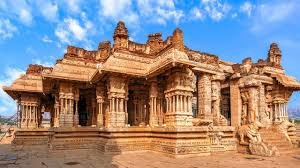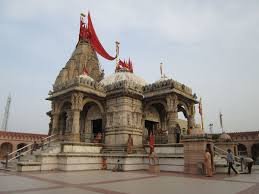The Vittala Temple in Hampi is an architectural masterpiece that reflects the grandeur of the Vijayanagara Empire. Known for its exquisite craftsmanship, stone chariot, and musical pillars, this temple is one of the most fascinating historical sites in India. Standing tall on the banks of the Tungabhadra River, it continues to mesmerize visitors with its intricate carvings and unparalleled design.
But what makes the Vittala Temple Hampi so extraordinary? Let’s dive into its history, architectural wonders, and cultural significance.
Historical Background of Vittala Temple
The Vijayanagara Legacy
- Initially, the temple was a simple shrine dedicated to Vittala (Vishnu).
- Over time, more mandapas, gopurams, and intricate sculptures were added.
- King Krishnadevaraya, known for his patronage of art and architecture, transformed the temple into a grand monument.
Unfortunately, after the fall of Vijayanagara in 1565, the temple was abandoned. However, despite centuries of neglect, its structural beauty remains intact, making it one of the most captivating sites in Hampi today.
Architectural Brilliance of Vittala Temple
The Vittala Temple Hampi is a masterpiece of Dravidian architecture, blending artistic excellence and engineering genius.
Key Architectural Highlights
- The Iconic Stone Chariot: One of the most famous attractions of Hampi, the stone chariot stands at the entrance of the temple. Unlike regular chariots, this one is carved entirely out of stone and is believed to be inspired by the Sun Temple of Konark.
- The Musical Pillars of Ranga Mantapa: The Ranga Mantapa is a spectacular hall with 56 musical pillars. When tapped gently, these pillars produce melodic sounds resembling musical notes—an engineering marvel that continues to amaze scientists and visitors alike.
- Exquisite Carvings and Sculptures: Every inch of the temple is adorned with detailed carvings depicting mythological scenes, celestial beings, and intricate floral designs. The craftsmanship here showcases the artistic brilliance of Vijayanagara sculptors.
- Majestic Gopurams and Mandapas: The temple has several mandapas (halls) and towering gateways (gopurams), each with unique carvings and ornate pillars. The Maha Mantapa, in particular, is a fine example of grand Vijayanagara architecture.
The architectural splendor of Vittala Temple Hampi truly makes it a symbol of artistic excellence and cultural heritage.
Spiritual and Cultural Significance
Even though worship is no longer performed at Vittala Temple, it remains a sacred site for Hindus and history enthusiasts.
- Lord Vittala – The Deity of Devotion: Lord Vittala is believed to be a form of Lord Vishnu, representing divine protection and guidance.
- Symbol of Vijayanagara’s Golden Age: This temple reflects the rich cultural and religious heritage of the Vijayanagara Empire, which was once the most powerful kingdom in South India.
- Pilgrimage and Tourism Hub: Today, it is not only a spiritual landmark but also one of the most visited historical sites in India, attracting tourists, photographers, and researchers alike.
Major Festivals and Events at Vittala Temple
- Hampi Utsav – This annual festival revives the grandeur of Vijayanagara with classical dance, music, and heritage walks.
- Vijaya Utsav – A grand celebration dedicated to Hampi’s rich history and architecture.
- Diwali and Dussehra – The temple complex is beautifully illuminated, making it an enchanting sight during the festival season.
During these events, Vittala Temple Hampi comes alive with cultural performances and historical reenactments.
Best Time to Visit Vittala Temple
- October to March – The weather is cool and pleasant, making it the best time for sightseeing.
- During Hampi Utsav – Experience the grandeur of Vijayanagara heritage during this festival.
- Early Mornings or Late Afternoons – Avoid the midday heat and enjoy the stunning play of light on the temple carvings.
Avoid visiting in peak summer (April – June) as Hampi can get extremely hot.
How to Reach Vittala Temple?
- By Road: You can hire taxis or take buses from Bangalore, Hospet, and Hubli.
- By Train: The nearest railway station is Hospet Junction (13 km away), with regular trains from major cities.
- By Air: The closest airport is Hubli Airport (165 km away) or Bangalore International Airport (350 km away).
From Hampi’s main bazaar, you can either walk or take a coracle boat ride across the Tungabhadra River to reach the temple.
Nearby Attractions in Hampi
- Virupaksha Temple – The oldest functioning temple in Hampi, dedicated to Lord Shiva.
- Hampi Bazaar – A lively street with ancient ruins, local shops, and eateries.
- Matanga Hill – The best spot for a panoramic view of Hampi’s ruins.
- Achyutaraya Temple – Another beautiful yet lesser-known temple nearby.
- Tungabhadra River – Enjoy a serene coracle boat ride along the river.
Exploring these sites along with Vittala Temple Hampi makes for an unforgettable historical journey.
Conclusion
The Vittala Temple Hampi is a marvel of ancient Indian architecture, engineering, and artistry. With its stone chariot, musical pillars, and magnificent carvings, it continues to be a source of awe and inspiration.
Whether you are a history buff, an architecture lover, or a spiritual seeker, this iconic temple offers an experience like no other.





